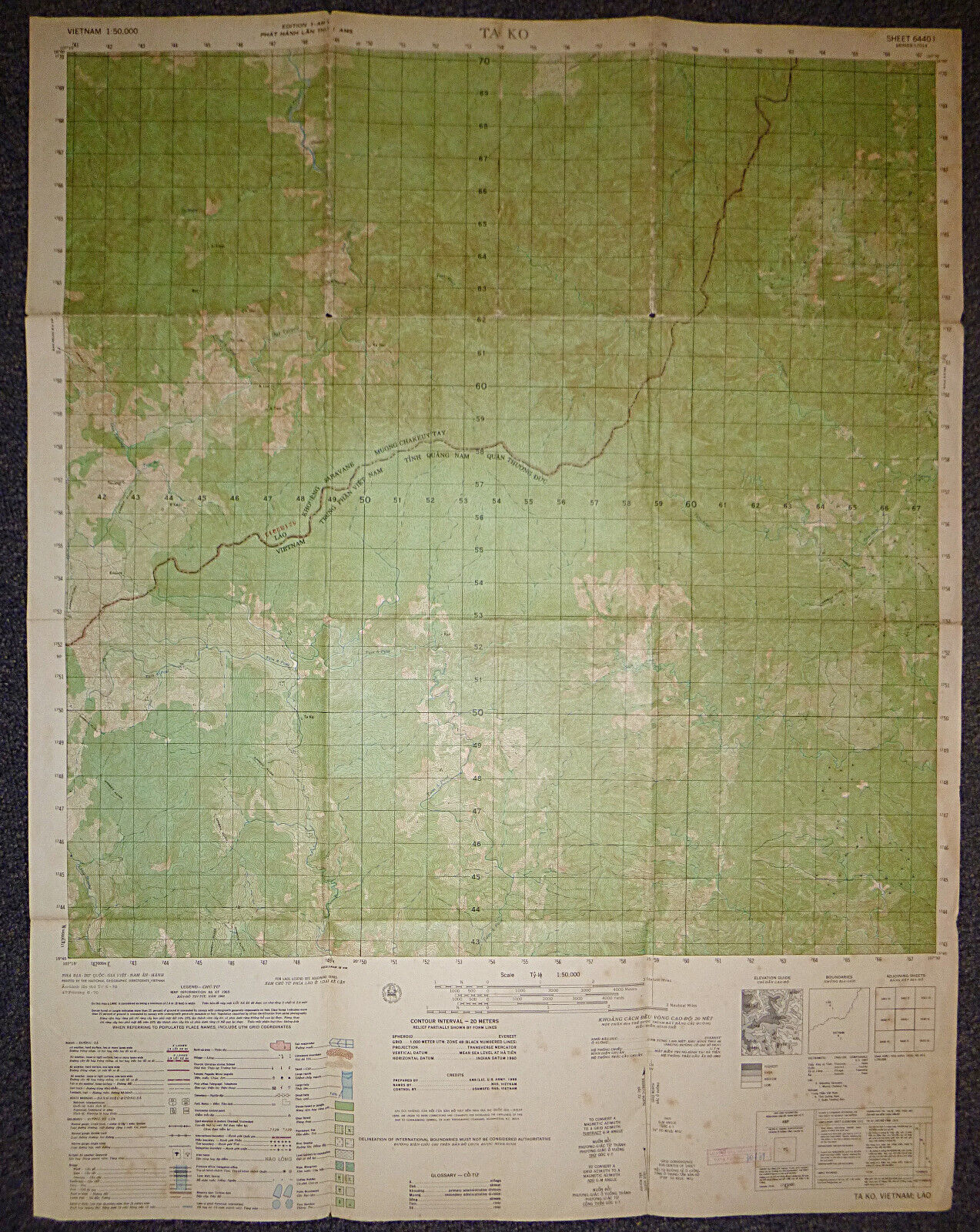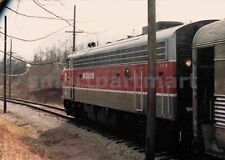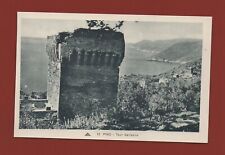6440 i - MAP - TA KO - LAOS - US Special Forces Base - HCM Trail - Vietnam War For Sale

When you click on links to various merchants on this site and make a purchase, this can result in this site earning a commission. Affiliate programs and affiliations include, but are not limited to, the eBay Partner Network.
6440 i - MAP - TA KO - LAOS - US Special Forces Base - HCM Trail - Vietnam War:
$384.99
TA KO - Laos - June 1970 - One Only Available (Ta Co)Extra Rare - Map - Ta Ko (also spelled Ta Co) - Vietnam / Laos Border - Ho Chi Minh Trail - CIA / US Special Forces Base - 5th / 7th Special Forces - Muong CHakeuy Tay - Khoueng Saravane - Quan Nam - Trung Phan Vietnam (North Vietnam).
Ta Ko (also known as Ta Ko Base or Ta Ko Outpost) played a significant role in the Vietnam War, primarily due to its strategic location and its use by the U.S. Special Forces and the Army of the Republic of Vietnam (ARVN). Here are the key points highlighting the importance of Ta Ko:
Strategic LocationProximity to Laos and the Ho Chi Minh Trail: Ta Ko was situated in the Central Highlands of South Vietnam, near the border with Laos. This area was crucial because it was close to the Ho Chi Minh Trail, a vital supply route used by the North Vietnamese Army (NVA) to transport troops, weapons, and supplies from North Vietnam through Laos and Cambodia into South Vietnam.
Control of Key Terrain: The Central Highlands were strategically important for controlling the movement of enemy forces. By establishing a base at Ta Ko, the U.S. and ARVN could monitor and disrupt NVA supply lines and troop movements.
Military OperationsSpecial Forces Operations: Ta Ko served as a base for U.S. Special Forces (Green Berets) and their South Vietnamese counterparts. These forces conducted reconnaissance, surveillance, and interdiction missions aimed at gathering intelligence and disrupting NVA operations along the Ho Chi Minh Trail.
Fire Support Base: The outpost also functioned as a fire support base, providing artillery support to nearby operations. This capability was crucial for defending the base itself and supporting patrols and engagements in the surrounding area.
Tactical ImportanceInterdiction of NVA Logistics: By operating from Ta Ko, U.S. and ARVN forces could launch operations to interdict NVA supply routes. This included ambushing convoys, destroying storage caches, and conducting airstrikes on enemy positions.
Defensive Operations: The base was fortified to withstand attacks, and its defensive operations were vital in maintaining a presence in the area. This included repelling enemy assaults and ensuring the security of the surrounding region.
Challenges and CombatVulnerability to Attack: Due to its proximity to enemy supply lines and operating areas, Ta Ko was frequently targeted by the NVA and Viet Cong. The base had to withstand mortar attacks, ground assaults, and infiltration attempts.
Logistical Difficulties: Operating in the remote and rugged terrain of the Central Highlands presented logistical challenges. Supplying and reinforcing Ta Ko required coordination and often faced difficulties due to weather conditions and enemy activity.
Broader ImpactIntelligence Gathering: The operations conducted from Ta Ko provided valuable intelligence on NVA movements and logistics. This information was crucial for planning larger operations and airstrikes against enemy supply routes.
Symbol of Resistance: Maintaining a base at Ta Ko symbolized the U.S. and ARVN commitment to controlling the Central Highlands and disrupting NVA operations. It was part of a broader strategy to deny the enemy uncontested use of key terrain and supply routes.
In summary, Ta Ko was important in the Vietnam War due to its strategic location near the Ho Chi Minh Trail, its role in Special Forces operations, and its function as a fire support base. Despite facing significant challenges, the base played a crucial part in the efforts to interdict NVA logistics and maintain control over the Central Highlands.
Operation Junction City (1967)Objective: Operation Junction City was one of the largest military operations of the Vietnam War, involving U.S. and ARVN forces. Its objective was to disrupt NVA supply lines and base areas in the Tay Ninh Province, which included areas near Ta Ko.
Combat: While the focus of Operation Junction City was not directly on Ta Ko, the operation involved significant combat in the region as U.S. and ARVN forces engaged NVA and VC units in the surrounding areas.
Operations in the Central HighlandsStrategic Importance: The Central Highlands, including the area around Ta Ko, were strategically important due to their location along the Ho Chi Minh Trail. This area was a key route for NVA logistics, making it a frequent target for U.S. and ARVN operations.
Engagements: Various engagements and skirmishes likely took place in the vicinity of Ta Ko as part of broader operations aimed at disrupting enemy supply lines and base areas.
Defensive OperationsBase Security: Ta Ko Base itself would have been the target of enemy attacks, including mortar and ground assaults. U.S. and ARVN forces would have engaged in defensive operations to protect the base and repel enemy attacks.
Reconnaissance and AmbushesSpecial Forces Operations: U.S. Special Forces teams operating from Ta Ko would have conducted reconnaissance missions and ambushes against enemy forces moving along the Ho Chi Minh Trail.
US MILITARY MAP - Very Rare
Vietnam War MAP
- Measures - 29 x 22.5 inches ( 74 x 59 cms )
- Series L 7014
This is an excellent and extremely rare piece. Originally compiled and with map information from 1968 (as noted on map) this piece was updated March 1974 with an overprint. Khe Sanh is now marked destroyed, Lang Vei still operating (supposedly), the airfield at Xom Cham (CIA) is still working, Lao Boa Prison is still open but the Airfield is not operational, both airfield\'s at Ban Houaysan now marked abandoned with the town marked destroyed. A terrific piece.
Lao Bao Prison
Original built by the French in 1908, Lao Bao was a prison located in the Quang Tri Province of South Vietnam during the Vietnam War. This prison was also known as the Lao Bao Special Zone Detention Camp or simply as the Lao Bao Prison. It was a facility used by the South Vietnamese government to detain and interrogate individuals suspected of supporting or sympathizing with the communist forces, particularly the Viet Cong and the North Vietnamese Army.
The prison was notorious for its harsh conditions and the mistreatment of detainees. Reports of torture, overcrowding, and inadequate medical care were not uncommon, and the conditions at Lao Bao were a source of concern and criticism, both domestically and internationally.
Khe Sanh - 1968
Khe Sanh is a district in Quang Tri Province, located in the northern part of South Vietnam, near the border with North Vietnam. The U.S. Marine Corps established a combat base there in 1962, known as Khe Sanh Combat Base. It was strategically located near the demilitarized zone (DMZ) that separated North and South Vietnam.
Buildup:
By the end of 1967, the U.S. military had detected an increase in North Vietnamese Army (NVA) activity in the Khe Sanh area. Intelligence suggested that the NVA was planning a major offensive, and they began to fortify their positions around Khe Sanh.
The Siege:
The Battle of Khe Sanh officially began on January 21, 1968, when the NVA initiated a siege of the combat base. For 77 days, the base was subjected to intense artillery and mortar fire, making it difficult for U.S. forces to receive supplies and reinforcements. The Marines and other U.S. forces at Khe Sanh were effectively cut off from the rest of South Vietnam.
Operation Niagara:
The U.S. launched Operation Niagara to provide air support and break the siege. U.S. Air Force aircraft conducted massive bombing campaigns in the surrounding area, which led to heavy casualties among the NVA forces.
Relief Efforts:
To relieve the pressure on Khe Sanh, U.S. Marines conducted a series of operations in the surrounding area, such as Operation Pegasus and Operation Scotland. These operations aimed to reopen Route 9, the main supply line to Khe Sanh.
End of the Siege:
By late March 1968, the NVA had suffered significant losses and decided to withdraw from the area. On April 8, 1968, the siege of Khe Sanh was officially lifted, and the U.S. forces regained control of the combat base.

Related Items:
6440 i - MAP - TA KO - LAOS - US Special Forces Base - HCM Trail - Vietnam War
$384.99
83a MONON F7A The Hoosier Line I.T.M. Vtg Train Photo 3.5x5 #6440
$8.99
PINE - Sarrazine Tour (i 6440)
$6.43



